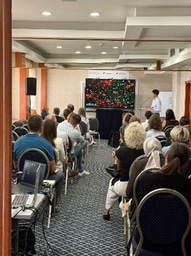Trilingual Basin found in Tarragona
Joan Guinovart: a colleague, friend and cultural link

One great and unexpected pleasure that came along during my decades of service to FEBS was the exposure to the broad and very diverse facets of Europe, from its physical scenes to the amazing variety of cultural wealth and diversity. The main underlying process that enabled and amplified this exposure was the routine whereby FEBS activities are spread over all the continent, not only the obvious ones like the annual congress or the courses, but the regular routine work of its committees is carried out through personal meetings that take place at sites where its members live. Namely, meeting sites are chosen by friendly agreement according to where committee members’ home places are. Hence, committee meeting places have been and are migrating over all European towns and countries, thereby, routinely presenting their members with new sites and human, cultural or other experiences. Thus, my FEBS activities allowed me to meet and collaborate with colleagues from different corners of Europe, from as far as Iceland to neighboring Turkey; with many we became personal friends. This experience has been of considerable importance for me because although being a native Viennese, growing up and living in Israel I hardly had any European exposure.
My first involvement in the FEBS functional bodies was being a member of its Fellowships Committee, elected in 1987, and serving from 1989 till 1991. This Committee was chaired then by Carlos Gancedo. He convinced me a few years later to try to run for this chair. Being elected in 1995 was the start of new, much closer and important involvement with FEBS since it meant responsibility for one of its major and most expensive activities, as well as becoming a member of its governing body, the FEBS Executive Committee.
A different important result of my joining the FEBS Fellowships Committee was meeting and working together with Carlos, the first of an increasing number of Spanish colleagues, leading scientists who were and still are central figures in the European molecular life sciences and research policies, from Federico Mayor to Miguel de la Rosa.
However, it is Joan Guinovart, with whom special relations had been established already from our initial meeting. We first met upon my joining the Executive Committee where he became a member after having organized the 1996 FEBS Congress. Afterwards, he was elected and served as the member responsible for FEBS meetings, primarily, its annual congresses. More recently he was elected President of the International Union of Biochemistry and Molecular Biology (IUBMB, 2015-2018) and represented it at FEBS Executive meetings. All these functions of Joan produced close and continuous contacts between us.
This acquaintance was intense and became unique all over the past decades. Already during our first meeting, Joan shared with me his experiences as a fellow pursuing research for several months at the Hebrew University Medical School in Jerusalem. Moreover, unexpectedly, he used a few terms of the Hebrew language which he still recalled from his Jerusalem period. I was impressed also by his knowledge, though limited, of the Hebrew script, which he gained then and expanded later, to be used even in our e-mail exchanges, as illustrated below:
חג חנוכה שמח שנה טובה ומתוקה
Best regards, Joan
This starting point of intense discussions soon developed into a tradition where Joan used to bring up topics of biblical or Jewish history. What came up as repeated surprises to me has been his wide and deep knowledge of the Old Testament and a range of historical and cultural related topics. Thus, it became a regular part of all our encounters during FEBS Executive Committee and other meetings that he would bring up a question or term asking for its background or rationale. Frequently it was the name of a specific prophet, challenging me for example about the impact that this man brought about in Jewish history.
The following anecdote illustrates how deep was his knowledge. In fact, it even reminded me about forgotten details: It started with Joan asking why, in a particular Jewish prayer, the names of two Israelite tribes, (Ephraim and Menashe), are treated differently from those of all other twelve tribes, traditionally constituting the Israeli nation. Well, that was a surprise question and not simple to answer.
It took me some time to re-learn the details. The Old Testament teaches that the 12 tribes originate in the descendants of the Patriarch Jakob (later renamed Israel). Jacob had indeed 12 sons: Reuben, Simeon, Levi, Judah, Dan, Naphtali, Gad, Asher, Issachar, Zebulun, Joseph, and Benjamin. Significantly, the most favored son, was Josef (not the youngest Benjamin…). As the biblical story further tells us, this favoritism yielded extreme envy of the 11 brothers who had therefore sold Josef off as a slave. The end of that much longer chapter had eventually brought the whole family back together, yet made Jakob raise the status of Josef by making his two sons equal to that of his brothers, making up the origin of Israel: Reuben, Simeon, Levi, Ephraim, Judah, Issachar, Zebulun, Dan, Naphtali, Gad, Asher, Menashe and Benjamin. This answered Joan’s interesting question that illustrates his amazingly detailed knowledge and deep interest in the Jewish religion and history.
It raised a point that led me back to reread and learn that specific complicated biblical chapter. Still, the range of issues we’ve addressed was much broader and had most probably their roots in Joan being a native of Tarragona, one of the most ancient Jewish communities in Spain which had an important role in their history and culture. Indeed, the photo shown below, that Joan e-mailed me years ago, illustrates archeological evidence for this community and its very early age. It shows the so-called Trilingual Basin found in Tarragona. It is dated to the fifth century AD and carries decorations typical for the Jewish tradition such as the seven-armed candelabra along with three inscriptions, one in Hebrew with the message “Peace upon Israel and upon ourselves and upon our children”, another in Latin, and a third in Greek. This archeological finding is perhaps a most appropriate physical illustration of the link, emotional and cultural that bound Joan and me together over decades and across the separating Mediterranean.
We shall always keep his memory deep with us.






Join the FEBS Network today
Joining the FEBS Network’s molecular life sciences community enables you to access special content on the site, present your profile, 'follow' contributors, 'comment' on and 'like' content, post your own content, and set up a tailored email digest for updates.